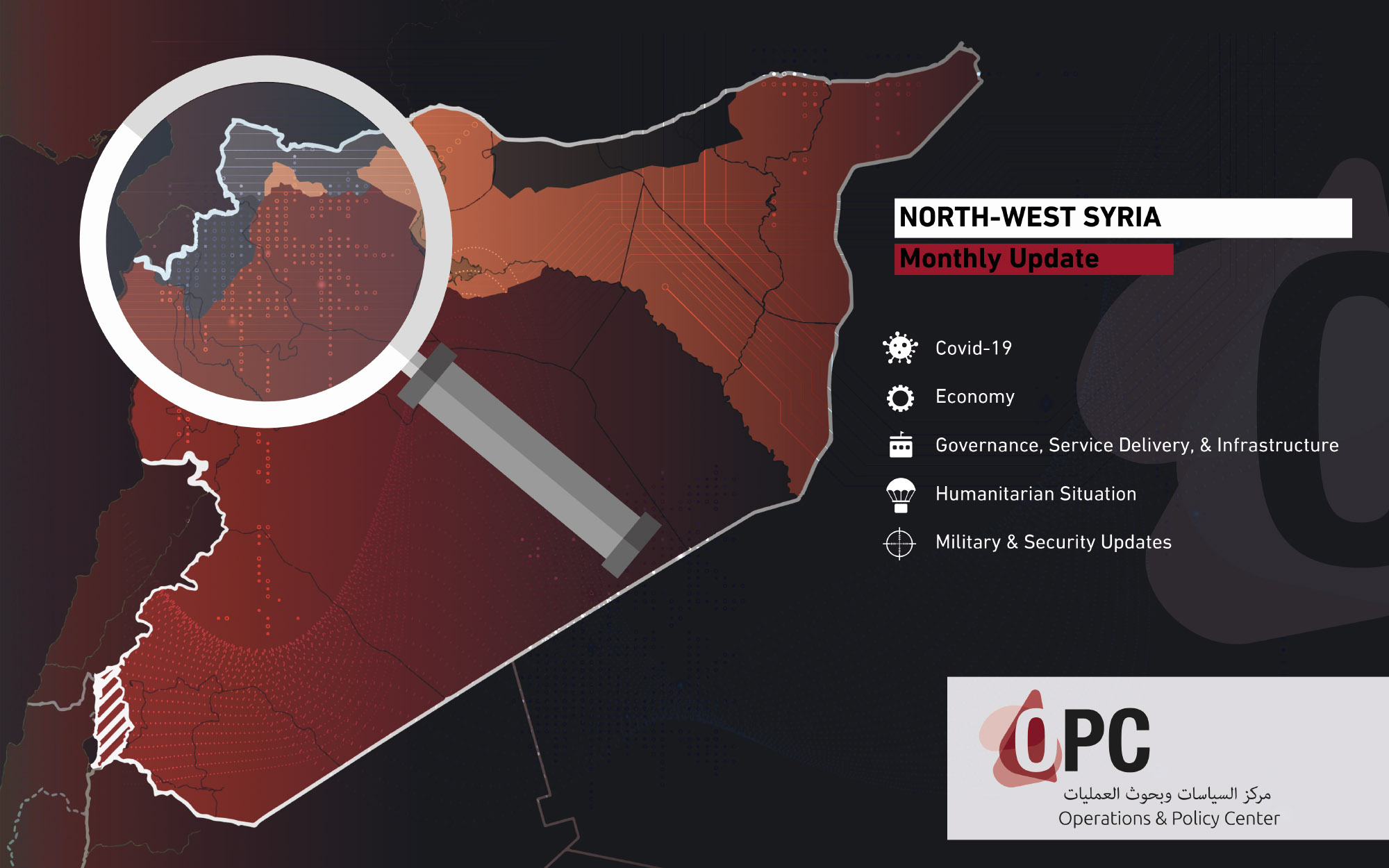
Contents
1. Living Conditions
2 Governance and Service Delivery
3 Economy
4 Military and Political Update
4.1 Regime/Russian Escalation
4.2 The Continued Expansion of Turkey’s Military Presence
4.3 HTS Security Campaign
4.4 Further Confrontations with the SDF
4.5 Further Confrontations with the SDF
Methodology
This report provides an overview of the situation in north-west (NW) Syria—areas controlled by Hay’at Tahrir al-Sham [HTS] and the Syrian National Army [SNA]—over the month of July, in terms of living conditions, the economy, governance and service delivery, the political and military situations, and security. The report is based on data collected by The Operations & Policy Center (OPC) through interviews with activists, humanitarian workers, and members of local councils (LCs), in addition to a comprehensive desk review of official data, media reports, and social media.
1. Living Conditions
1.1 Covid-19 Update
Despite no new variants being reported so far in NW Syria, and a decline in the number of new cases reported in July to 771 (compared with 2,120 cases reported in June), health experts and doctors in the region are warning that vaccine hesitancy is hampering efforts to immunize the population. This hesitancy is caused mainly by negative media reports on the side-effects of the AstraZeneca vaccine and the conspiracy theories circulating widely on social media regarding Covid-19 and the efficacy of any of the vaccines.
A doctor working in northern Idlib has stated that in addition to opening more vaccination centres and communicating the availability of the vaccine to the public, there is a need for widespread awareness campaigns in NW Syria that counter the damaging effects of conspiracy theories and urge people to get vaccinated in simple, straightforward language that addresses their concerns without condescending to them or dismissing their fears. The health directorates, along with other humanitarian organizations, have also warned of the ramifications of the regime/Russian military campaign on the area and the ensuing displacement from the south of Idlib towards overly crowded Internally Displaced Persons (IDP) camps in the north.
Numbers show that the vaccination campaign pace has slowed, as only 5,537 people were vaccinated in July, compared with 16,783 in May and 23,742 in June.
A detailed breakdown of Covid-19 cases (from the first case reported in June 2021 until 31 July 2021) and the distribution of AstraZeneca vaccinations are provided in the dashboard below. The vaccination campaign, which started on 1 May 2021, was implemented and is coordinated by World Health Organization (WHO), Turkey’s Assistance Coordination Unit (ACU), the Syria Immunisation Group, and the Health Directorates in Idlib and Aleppo.
1.2 Humanitarian Conditions
The ongoing regime/Russian escalation, which started in early June, has caused a new wave of displacement in the Jabal Al-Zawiya area in the southern countryside of Idlib. According to the Response Coordination Group, as of 25 July more than 4,361 civilians have been displaced from Jabal al-Zawiya. 241,783 civilians remain at risk of displacement from daily attacks on residential neighbourhoods, vital infrastructure, and health, first response, and service facilities.
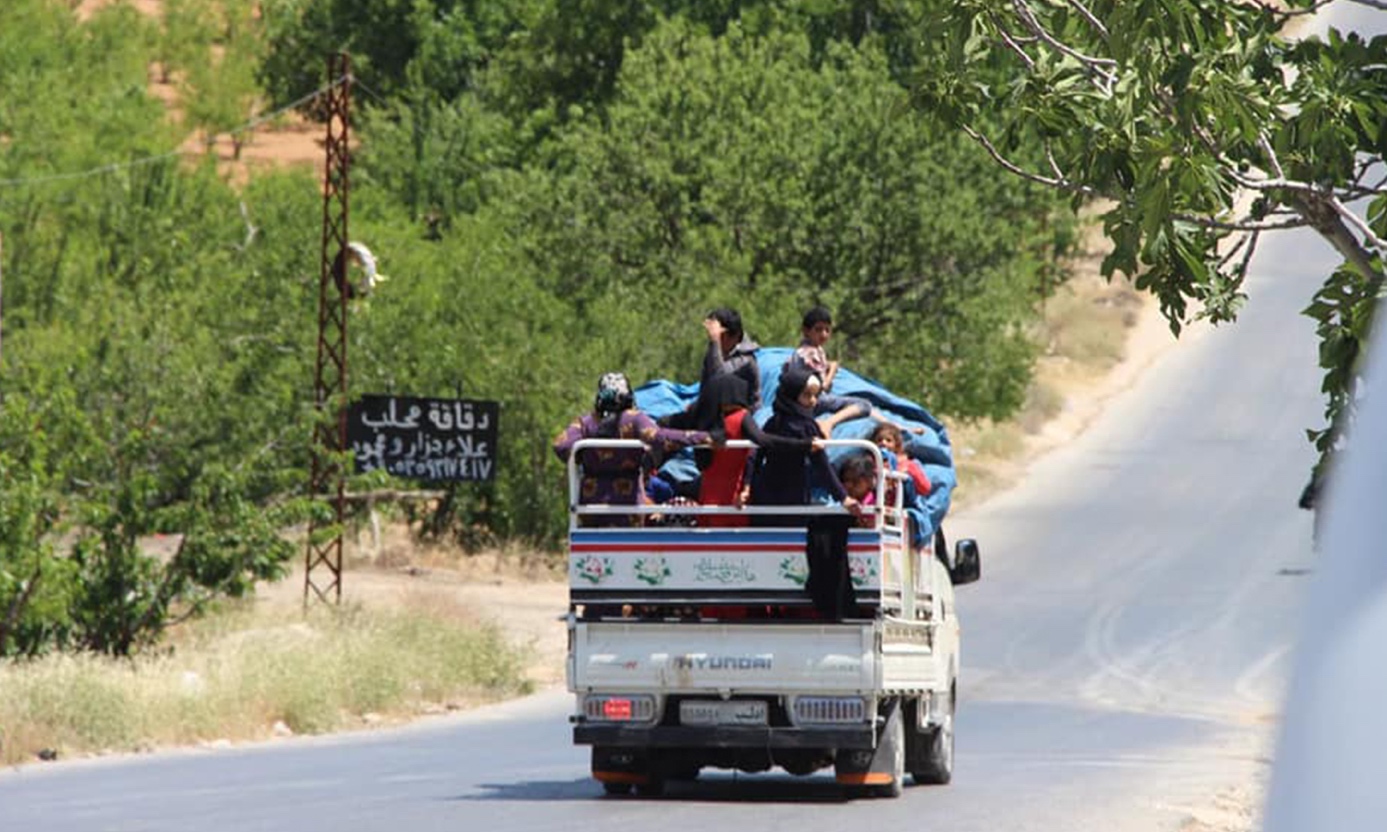
Civilians fleeing the attacks on Jabal al-Zawiya in June 2021 – Courtesy of the Syrian Civil Defence
Displacement began in early June, but was limited to families who have a place of residence in safer areas. However, as attacks intensified, larger waves were recorded from the communities of Safra, Baloun, Abadita, Ablin, and al-Bara, where the displacement rate exceeded 70% according to an activist from the area. The journeys have reportedly been brutal, especially with the increasing heat and the scarcity of drinking water centred across IDP camps, which face a water crisis.
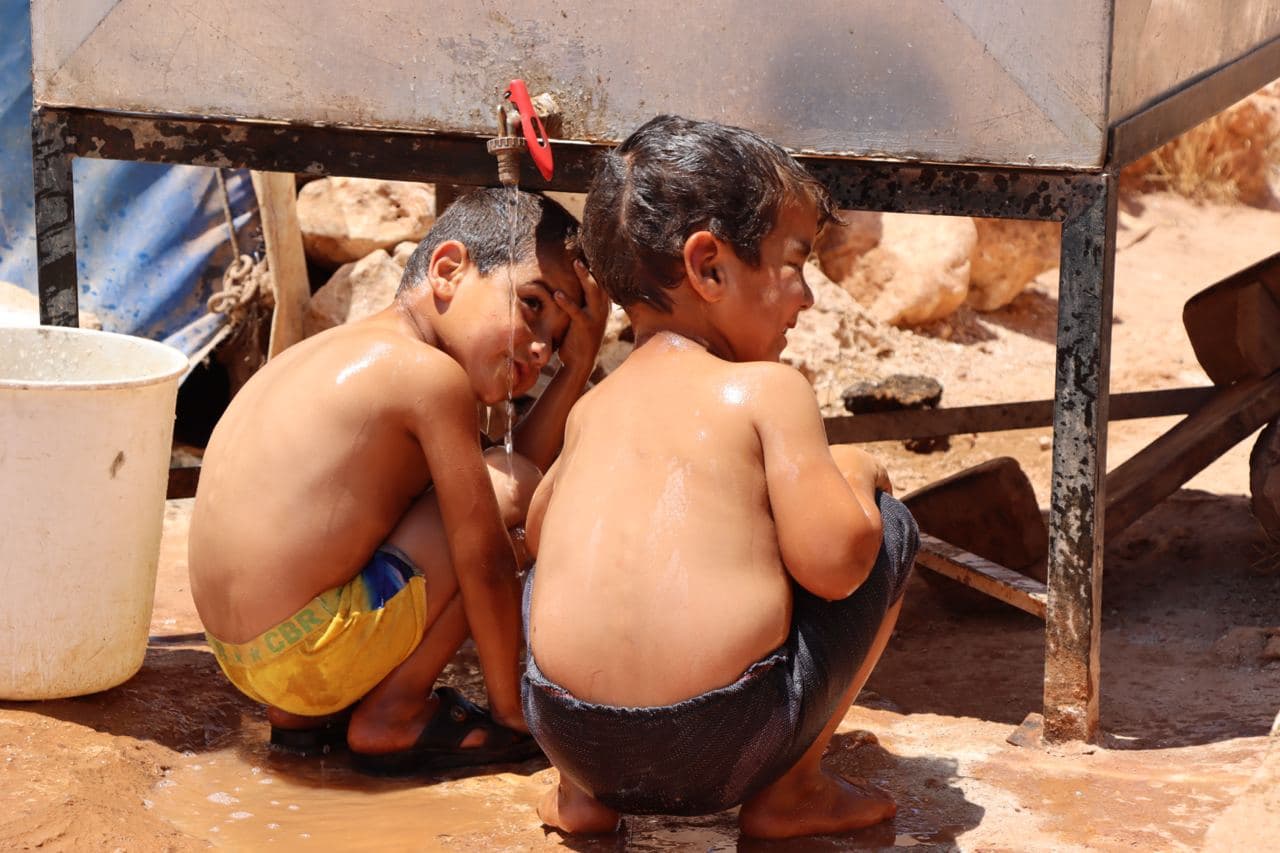
Children using water to deal with the hot weather in an IDP camp in NW Syria (June 2021) – Courtesy of the Syrian Civil Defence
Humanitarian workers and Civil Defence responders reported great difficulties during response operations, as they were targeted several times during June and July. The daily attacks on residential areas have caused several medical facilities in the area to close due to intense bombing; in Ablin, Civil Defence first responders were forced to transfer the injured to Ariha city for treatment.
The attacks have also caused the shutdown of schools and educational centres in 14 towns and villages including Fatira, Kansafra, Safra, Abadita, Ablin, Baloun, al-Wazzara, al-Bara, and some schools in Ehsem, Deir Sunbul, Sarga, and Bazabour.
Despite these developments and the ongoing reporting by local and international NGOs on the humanitarian crisis in NW Syria—especially in the 1,489 formal and informal IDP camps where 151,2764 people currently live—the humanitarian response across all major sectors remains severely inadequate, according to updates published by the Syrian Response Coordination Group.
Below is the rate of humanitarian response within IDP camps during the months of May, June and July 2021:
2. Governance and Service Delivery
2.1. Alternative Energy
Unlike SNA areas, where electricity is provided through Turkey, the ongoing rise in fuel prices over the past months have caused a widespread energy crisis in HTS areas, forcing people to seek out alternatives. This has created an unexpected boom in solar power, as the sun has become the cheapest source of electricity around, especially during the summer.
Reportedly, around 8% of the population in NW Syria currently rely on solar power. According to sellers, most households opt for four panels (240 watts) and two batteries, which cost around 4500 TL (about $530 USD using 14 Aug exchange rates). This setup provides enough power to run a refrigerator, water pump, or washing machine during the day, and lights and a television at night. But helpful as it is, the setup is not cheap; it is beyond the means of the vast majority in an area with 50-70% unemployment and where the average monthly income for labourers is 500 TL ($58 USD), 1600 TL ($188 USD) for employees in humanitarian organisations, and 1200 TL ($141 USD) for HTS’s Syrian Salvation Government (SSG) employees.
Some farmers and workshop owners, who can no longer run their businesses due to diesel prices, are investing in larger packages of 100 to 240 400-watt solar panels costing up to 240,000 TL (about $26,200 USD). Prices of these panels vary according to capacity and the manufacturing country.
Many IDPs living in the camps, despite extreme destitution, have managed to invest in at least one solar panel that produces enough energy to charge their phones and power small LED lights at night., Those with more resources opt for 3–4 panels to power internet routers and televisions. Despite the high cost of the panels, people in Idlib consider it the most viable and reasonable long-term investment they can make, even with news about electricity coming back to Idlib through Turkey.
Those who cannot afford solar power or the expensive fuel offered by Watad Petroleum are opting for more traditional power alternatives, especially for cooking and heating. Cattle dung mixed with hay and water is formed into tablets and dried under the sun, to be used later to light cooking fires.
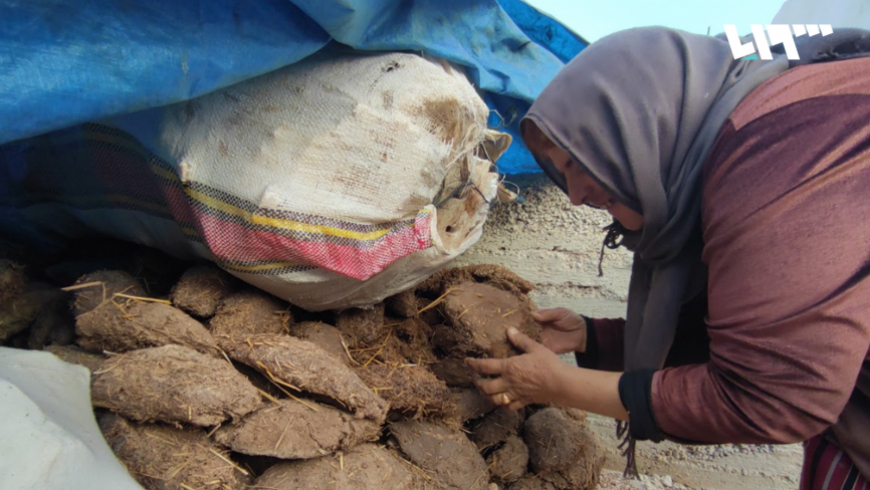
An IDP woman in Idlib stacks cow dung to be used as cooking fuel (July 2021) – Courtesy of Syria TV
2.2 Electricity Supply
The newly re-established access to electricity in Idlib for the first time in six years is expected to mitigate the energy crisis in NW Syria. The agreement signed a year ago between the SSG and Green Energy company to import electricity from Turkey has already provided grid-access electricity in of Idlib’s several key cities, and partial access for other communities. Electricity has begun to reach Idlib City, Salqin, Dana, and Sarmada, with more towns and cities in northern and western Idlib to follow soon, providing comprehensive coverage across most of the province. The city areas were prioritised because of population density and proximity to the substations.
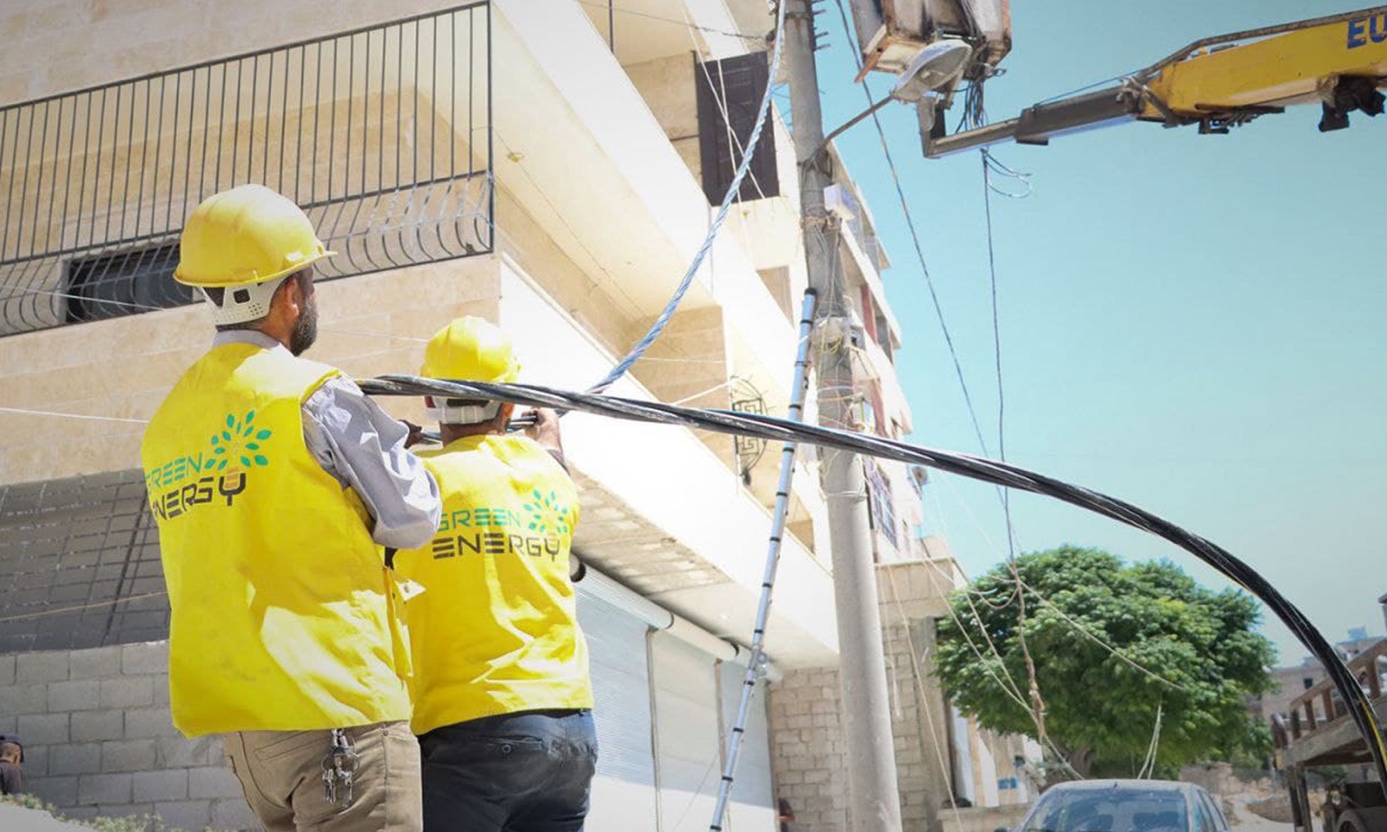
Green Energy workers connecting electrical networks in the city of Salqin, north of Idlib – Courtesy of Enab Baladi
In order to access this new grid, subscribers must purchase new electricity meters—either a single-phase meter for 350 TL with a subscription fee of up to 100 TL per month, or the three-phase meter for 900 TL with a subscription fee of 400 TL per month. Subscriptions will be prepaid through special cards. The subscription cost is significantly lower than the current costs of accessing electricity from local generators.
The gradual supply is limited by the state of infrastructure in Idlib, devastated by regime attacks, which requires considerable repairs and new equipment. But according to data collected by OPC field researchers in northern Idlib, even partial access to electricity (currently restricted to bakeries and water pumps) has already lowered costs by 20%.
3. Economy
This monthly report will provide ongoing tracking of the exchange rates of the Turkish Lira (TL) and the USD in both HTS and SNA areas, along with prices of some staple food items and the monthly costs of electricity and water. We aim to give readers an idea about the discrepancies of living costs between the two areas, and to provide a reference point for understanding the general state of the economy and consumer power in NW Syria.
Below are the exchange rates and prices for fuel, a number of staple food items, and the monthly costs of electricity and water across SNA and HTS areas. Exchange rates and prices were collected by field officers from Azaz in SNA areas, and from Idlib City in HTS areas. In both SNA and HTS areas people rely on the delivery of water through private vendors; the cost of water is calculated per 220-litre tank, with the average usage for a family of 5 around 20 tanks per month for a total of 4,400 litres. SNA areas receive electricity through Turkey, while the vast majority of HTS areas rely on private vendors, with consumption calculated per ampere; 1 ampere equals a monthly usage of 3.5 hours per day. The average monthly usage per 5-person family is 2 amperes.
3.1. Industrial Cities in SNA Areas
Work continues on the Azaz and Jarablus industrial cities. According to the local councils (LCs) of both cities, these specialized zones are expected to provide job opportunities for about 10,000 people, stimulate the economy, bring back industrialist and capital owners who were forced to leave the area, and create a sustainable investment in the local Syrian labour force. Industrialists and capital owners are expected to be offered several incentives: most importantly, lower investment and manufacturing costs compared with neighbouring countries, and the easing of passage to and from Turkey.
At the beginning of June, work started on the Jarablus industrial city. Jarablus LC announced that both male and female investors in the industrial city will be offered a one-year pass to enter Turkey, and that Turkish citizens are allowed to invest in the city. These incentives are offered in order to entice Syrian businessmen, especially those based in Turkey, to invest. The city will include 200 lots, classified into three groups: group A lots will be offered for $7500 USD, group B lots for $7000, and group C lots for $6000.
Work continues on the Azaz industrial city 7 km east of the city limits, a project supervised by the Turkish government (Killis governor) and the Azaz LC, and funded by Turkey. This project, intended to revive production and manufacturing in the Syrian north, is expected to be completed by the end of this summer. A similar city was inaugurated in al-Bab in December 2018.
Despite the promises of economic recovery and a rise in employment, there has been much criticism in the local community regarding the project location (agricultural land that could have been cultivated) and the lack of defined parameters to protect local markets, consumers, and investors in the face of Turkish interests.
4. Military and Political Update
Further details on these incidents and the escalation casualties mentioned in this report can be found in the Incidents Dashboard attached below.
4.1. Regime/Russian Escalation
Regime and Russian forces have increased the level and frequency of their attacks on Idlib, northern Latakia, and western and northern Aleppo over the past 9 weeks, especially in the Jabal al-Zawiya area. Though the Russian escalation can be viewed as a warning about the high cost of denying Moscow its way on the UN Security Council on Syrian matters, and Russian expenditures to maintain the status quo instead of a threat of full-scale war, it also presents the danger of a direct Russian-Turkish military confrontation in Idlib.
Yet its humanitarian cost on NW Syria has been severe. According to the Syrian Civil Defence and the Syrian Response Coordination Group, between 3 June and 25 July there were 791 documented violations of the 5 March ceasefire agreement, including over 19 instances of targeting service and medical facilities and IDP camps. The number of civilian casualties has reached 65, including 29 children, ten women, and five humanitarian workers.
The intensity of the regime/Russian attacks in the Idlib and Hama countrysides subsided ahead of the 30 June Russian-Turkish talks between Russian Foreign Minister Sergey Lavrov and his Turkish counterpart, Mevlut Cavusoglu. During the meeting, Russia and Turkey reached an understanding to bring military operations in Idlib to a halt for 72 hours, and to implement the March 2020 agreement in regard to establishing a zone free of all military presence in Idlib. The two sides did not clarify what is meant by this “military-free zone”, nor whether it is the “safe passage” on both sides of the M4 which was agreed upon in the ceasefire agreement on 5 March 2020.
The escalation intensified with the approach of the UN Security Council (UNSC) vote over the Syria Cross-Border Humanitarian Mechanism. Moscow maintained it would veto any mechanism that sidelines the Syrian regime, especially as Turkey and the US appeared to be in agreement about working together to extend and expand the mechanism to ensure unhindered humanitarian access to northern Syria.
On 3 July, a regime artillery bombardment on Ablin, Baloun, and Balshoun in Jabal al-Zawiya killed nine civilians—a man, a woman, and seven children—and wounded scores of people. Additional attacks on Ariha city wounded five people, including four children. That same day, Russian jets destroyed the northern Rouj water station, which irrigates about 3,500 hectares of agricultural land in the western countryside of Idlib. They also targeted the Civil Defence centre in Sheikh Youssef, causing serious damage to the building and injuring six Civil Defence members. The centre provides emergency and ambulance services to about 40,000 civilians across 13 villages and towns in the Sahel al-Rouj area in Idlib’s western countryside.
In the days leading to the sixteenth round of Astana talks (7–8 July) and the UNSC vote on the Cross-Border Humanitarian Mechanism (9 July), regime and Russian forces targeted the vicinity of the Turkish military post at al-Bara, in Jabal Al-Zawiya, with heavy artillery shelling. On 9 July, the day of the Security Council vote, regime and Russian forces targeted Jabal al-Zawiya and the northern countryside of Latakia with more than 100 missiles, raids, and artillery shells. Most targeted residential neighbourhoods, causing widespread destruction.
The sixteenth round of Astana talks—held in Kazakhstan’s capital, Nur Sultan—have ostensibly failed to offer anything new in terms of applicable measures or agreements to stabilise the situation in Idlib and end the violence. The final statement issued by the participants reiterated Russia, Turkey and Iran’s commitment to “de-escalation” in Idlib, the implementation of all previous agreements regarding the province, and enhancing cooperation among the three countries to combat “terrorist” activities in the region. The statement did not address the ongoing Russian escalation or measures intended to end it.
But despite the lack of any tangible progress, Ayman Al-Asimi, the spokesperson for the Syrian opposition participating in the meetings, stated that the outcome of the talks was not expressed in the final statement, and that the real success was ensuring Russia would not veto humanitarian access through Bab al-Hawa for the next six months. Al-Asimi added that the Constitutional Committee is another issue which has been advanced during the talks.
The progress regarding humanitarian access was proven on 9 July when the UN Security Council extended the humanitarian aid delivery mechanism to Syria through Bab al-Hawa crossing for a period of six months, with the possibility of renewal for another six months.
However, only hours after the UNSC passed a resolution extending the mechanism for cross-border international aid through Bab al-Hawa crossing, Russian warplanes and regime forces resumed their bombing and shelling of several areas in the Idlib and Latakia countryside.
The intent here appears to be a new message to Ankara and Washington that stability and calm in Idlib remain dependent on Moscow’s will, not on any Turkish-American agreement. It is also believed that Russia intends to keep Idlib in a state of limbo; neither all-out war, which avoids a Russian confrontation with Turkey, nor stable peace, which might lead to an economic boom while regime areas drown in governance and economic crises.
Russian-regime attacks in Idlib continued to target civilians in the Jabal al-Zawiya area. On 15 July, an attack in Ablin killed a woman and two children and injured four other children. On the same day, a regime artillery attack on al-Foua in Idlib killed six civilians and injured eight others. On 17 July, three children and their grandmother were killed during regime artillery shelling on the village of Sarja, south of Idlib. During rescue operations, Civil Defence teams were targeted with Krasnopol laser-guided shells, injuring three team volunteers.
Regime and Russian forces launched an attack on 18 July, using Krasnopol shells on residential neighbourhoods in Ehsim in the southern countryside of Idlib, killing eight civilians—four children and four women. Nine additional civilians, including four children and three women, were injured. On the same day, an attack on Baloun in Jabal al-Zawiya injured two girls. Another regime artillery attack targeted a residential house in Daret Izza, in the western countryside of Aleppo, killing a child and injuring five other members of the same family.
On July 20, the second day of Eid al-Adha, a civilian was killed and 19 others (including five children) injured as regime forces targeted a civilian car near a restaurant on the road near Badama in western Idlib.
One of the most violent attacks occurred on July 22, when a regime attack with Krasnopol guided artillery shells on Ablin devastated the Harmoush clan. This is the clan of Lieutenant-Colonel Hussein Harmoush, one of the earliest officers to defect from the regime’s army and founder of the Free Officers Movement, giving the attack a symbolic significance. The attack killed seven clan members, including four children and a woman. Seven others, including two children, were wounded. The attack also demolished a number of residential homes; the Civil Defence evacuated more than 210 people, including 50 children under the age of 14.
The final reported July attack on civilians occurred on the 25th when a residential neighbourhood and the Civil Defence centre in Afrin were bombed, injuring four children and two women. The attack is highly likely to have been carried out by the regime, but it could also have been conducted by the SDF.
4.2. The Continued Expansion of Turkey’s Military Presence
Prior to and during the regime/Russian escalation, the Turkish army continued to send reinforcements and equipment to Idlib. A new military convoy of Turkish forces entered NW Syria through Kafr Lucin crossing on 13 July. The convoy consisted of 42 military vehicles, including a tank, a rocket launcher, a crane, a military bulldozer, and trucks loaded with ammunition and logistical equipment, in addition to several armoured vehicles and dozens of Turkish soldiers. This convoy joins the extensive Turkish military presence across 77 military bases and posts in Idlib and western Aleppo, part of the Turkish strategy to bolster their military presence in Idlib in order to deter a full-scale regime/Russian offensive in the area.
Despite the heated confrontation in Idlib, Turkish and Russian forces conducted 2 joint patrols during July, on the 6th and the 13th, in the Kobani countryside. The patrols, which consisted of four Russian and four Turkish armoured vehicles accompanied by two Russian helicopters, started at Gharib village (eastern Aleppo) and reached Bandar Khan village (eastern Aleppo). One patrol then reached the outskirts of western Tal Abyad, north of Raqqa, before returning to its starting point in Gharib.
4.3. HTS Security Campaign
HTS continued its campaign against other jihadist groups, started earlier this year in an effort to consolidate its power, strengthen its hold on Idlib and western Aleppo, and rehabilitate its image and obfuscate its radical origins and ideologies. Arrests were not limited to members of jihadist groups, but included media activists and other civilians accused of supporting the Assad regime.
HTS’s campaign against other Jihadist groups in Idlib culminated in a raid on the Junud al-Sham faction in Latakia’s northern countryside—a group of mainly Chechen mujahideen led by Muslim Abu Walid al-Shishani, currently the most prominent foreign leader in northern Syria. The raid on the group was preceded by an announcement from HTS that several Junud al-Sham fighters are involved in criminal activities, a claim denied by al-Shishani. Following the raid, al-Shishani announced that HTS has asked the group members on more than one occasion to join its ranks or leave NW Syria, and that he plans to leave along with his fighters following failed negotiations; he has asked HTS to extend the deadline for Junud al-Sham fighters to leave the region.
The HTS security campaign was not restricted to rival or opposing jihadist groups. On 30 June, HTS arrested three individuals alleged to be working as cells for the Syrian regime, and to have been involved in the bombing of a weapons cache in Idlib city on 18 January of this year, in which two people were killed. On 15 July, HTS arrested a doctor from his clinic in al-Dana. The reasons behind this arrest remain unknown. On 21 July, HTS security raided the house of an IDP from Aleppo city and arrested him. The man has created a cat sanctuary in Idlib city; the reason for his arrest is believed to be because he receives support from foreign organisations.
4.4. Further Confrontations with the SDF
The confrontation between Turkish/Syrian National Army (SNA) forces and Syrian Democratic (SDF)/Afrin Liberation forces, which began with Operation Euphrates Shield in 2017 and Operation Olive Branch in 2018, continue with mutual artillery and rocket barrages, infiltration attempts, and almost-daily clashes on several fronts in Aleppo’s northern and eastern countrysides. Thus far neither side has managed to score any strategic wins to change the conflict map, and it appears from the current state of affairs that any such changes are not expected in the near future.
On 2 July, a newly-joined member of the SNA’s Sultan Murad Brigade shot and killed three members of the same group and wounded two others while they were at a military post in the north-west of Manbij, near the contact lines with the SDF’s Manbij Military Council. Following the attack, the killer managed to flee to SDF areas. This is not the first attack of this kind; on 18 May of this year a member of the SNA’s Malik Shah faction opened fire and threw a grenade at two other faction members inside the Malik Shah headquarters in the Sharan area of Afrin, killing them immediately.
On 10 July, the SDF attacked the countryside of Azaz and Afrin with artillery shells, killing a civilian and injuring another. On July 16, two civilians (one a child) were killed and ten others wounded in an SDF missile shelling on Afrin City.
Another attack targeted a residential neighbourhood and a Civil Defence centre in Afrin City on 25 July, but the culprit remains unknown—the SNA accused the SDF, while activists indicated it was most likely a regime attack. The missile strikes injured eight civilians, including four children and two women. According to the Civil Defence, the missile strikes came from areas in the northern countryside of Aleppo controlled by Assad’s forces and the SDF.
The most significant attack—at least in terms of Turkish retaliation—came on 24 July. Two Turkish soldiers were killed and four others seriously injured when a vehicle at the Turkish military post near al-Bab city was hit by an SDF anti-armour guided missile. Turkish retaliation began with the bombardment of several SDF-controlled villages in the countryside of Aleppo. On 25 July, the Turkish Ministry of Defence announced the killing of seven SDF members in response to the attack on the 24th. The villages hit included Al-Sha’ala, Khirbet Al-Sha’ala, Zwayan, Suruj, Nyarabiyah and Al-Radar.
The SDF responded with a mortar attack on residential areas in Mare’ city, injuring a woman. Two days after the attack on the Turkish military post, senior Turkish army commanders conducted an inspection visit to the Syrian border where they held a number of meetings with other Turkish commanders in the area.
4.5. The SNA’s Security Campaign
In response to the numerous explosions targeting SNA areas (the details of which are listed in the Security Dashboard) and the rise in drug-related crime, a military campaign was launched by the SNA, local police, and military police in Euphrates Shield areas to stabilise the situation and pursue the perpetrators of the attacks. These efforts led to the formation of the unified command Azm on 15 July, to provide a higher level of coordination between the Levant Front and the Sultan Murad Division in security and military efforts, and to deliver more support to local police across areas controlled by the SNA. The efforts of Azm reportedly target saboteurs, drug dealers, criminal gangs, and those classified by the security forces as the most dangerous criminals in the region. These efforts are believed to be in response to Turkish “wishes” to raise coordination levels between SNA factions in order to combat the SDF, ISIS, and drug smugglers amid fears that HTS is trying to take advantage of the security chaos in SNA areas.
On the same day its organization was formally announced, Azm scored its first success with the arrest of more than 20 people wanted in drug trading and dealing cases in Azaz and Afrin cities.
On 21 July, the Levant Front and the Sultan Murad Division announced another joint security campaign under the name Operation Falcon’s Claw, targeting ISIS and SDF cells planning to carry out terrorist attacks in SNA-controlled areas.
Methodology
NW SYRIA UPDATES
This dashboard delivers monthly updates on several health, economic, and security aspects of north-west Syria (i.e., areas controlled by Hay’at Tahrir al-Sham [HTS] and the Syrian National Army [SNA]). In view of the differences between these two control areas in the political, economic, and governance areas, most of the data are classified accordingly.
The dashboard provides the following:
- Daily security and military incidents and casualties inflicted by them, disaggregated by:
- Area of control (HTS or SNA)
- The type of incident (Bombing or Shelling, Landmines, Transport Accident, Firearms, Clashes, Suicide Attack, Other Explosives, Other, Unknown)
- Victims (Civilian, HTS fighter, SDF fighter, SNA fighter, Regime or Allied Forces Fighter, Other, Unknown)
- Perpetrators (HTS, SDF, SNA, Turkish Forces, Regime and/or allies, Other, Unknown).
- Data is collected from social media and news reports. It should be noted that OPC does not have people on location to confirm the accuracy of each incident.
- The spread of Covid-19 in NW Syria, in terms of new cases, active cases, recoveries, deaths, hospitalisations, and the progress of the vaccination campaign. Information is collected from WHO, ACU, and the Syria Immunization Group.
- The USD and TL exchange rates in HTS and SNA areas at the end of each month. Exchange rates are collected by field officers in Idlib and Aleppo.
- The price of fuels in both areas at the end of each month, and fluctuations in fuel prices in HTS areas because of the volatility of the fuel market regulated by Watad Petroleum. Prices are collected from field officers, media reports, and Watad social media platforms.
- The average monthly costs of water (per 5-person family average use of 4400 litres) and electricity (per 5-person family average use of 2 amperes). People in both SNA and HTS areas rely on water delivery through private vendors. While SNA areas receive electricity through Turkey, the vast majority of HTS areas still rely on private vendors. One ampere equals 5 hours of electricity per day in a household, to run a refrigerator, a washing machine, a TV, lighting, and charging mobile phones.
- Prices of key staple food items, collected by OPC field researchers at the end of each month. Prices are collected from Azaz (SNA) and Idlib City (HTS); the price provided in the dashboard is the average from each area.
- The rate of humanitarian response in IDP camps across NW Syria—i.e., the percentage of available response compared to community need in each of the following sectors: health, shelter, education, protection, food security, WASH (Water, Sanitation, and Hygiene), and NFI (Non-Food Items). Data is collected from the Syria Response Coordination Group.